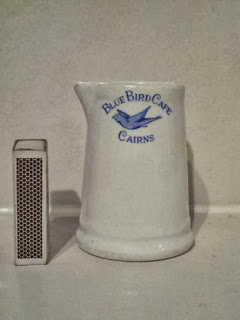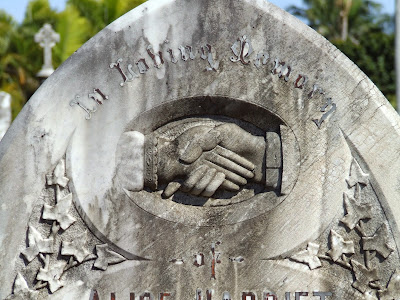.JPG) |
| CWA shark-proof swimming enclosure, 1956. Photo courtesy: Tony Christensen and Michael Christensen. |
 |
| Opening of CWA Hut at Kissing Point, Townsville. Photo courtesy: CityLibraries Townsville Local History Collection. |
On the 4th January 1933, a shocking fatality
occurred opposite the CWA huts. A 38
year-old shearer’s cook named Stanley Victor Locksley, who was holidaying from
Hughenden, was attacked by a shark while swimming at Kissing Point. The large shark (thought to have been a grey
nurse shark) inflicted massive stomach wounds and Locksley died from his injuries. Ironically, at the annual meeting of the CWA
the previous year, a resolution was submitted by the Prairie branch ‘that steps
be taken to collect money for a safe bathing enclosure’. The resolution had been carried unanimously.
The attack on Locksley ‘clearly demonstrated’ to the
executive of the CWA that ‘bathing in the sea without protection, was utterly
out of the question’. Moves were then
made to begin canvassing support for the erection of a shark-proof swimming
enclosure. Because the enclosure would
benefit northern and western visitors to Townsville’s CWA huts, branches of the
CWA right throughout north Queensland Richmond , £10; Stone
River
Somewhat surprisingly, the CWA initially encountered
opposition from the City Council, who opposed the construction of a swimming
enclosure opposite the huts. The council
was against ‘further obstructions breaking the continuity of the beach’. To placate the CWA, the council offered to
provide all occupants of CWA huts with free admission to the city baths
(located further along The Strand). But
this did not dampen the CWA’s resolve to provide their members with a safe
swimming enclosure. Plans and
specifications were drawn up by honourable architect C.D. Lynch, and after much opposition the authority of the
Governor-in-Council was obtained on 9th June 1933. By this time the City Council, Harbour Board
and Marine Department had finally agreed to the project.
The enclosure was erected by volunteer labour and with the help of assistance from local businesses who provided trucks to carry timber piles as well as help from the Council and Harbour Board (who provided a pile driver). Mr St. John Robinson conducted three refreshment booths and catered for a private luncheon for 60 people at his rodeo, and donated the proceeds to the project. The enclosure itself measured 70 yards by 40 yards and was made of large ti-tree piles, spaced 10ft apart, with specially-made, heavy duty 4 ½ inch-thick chain mesh.
 |
| CWA Huts, Kissing Point, Townsville, 1932. Photo courtesy: CityLibraries Townsville Local History Collection. |
Sources:
Townsville Daily
Bulletin, 22 September 1924, p. 4; 6 September 1933, pp. 3 & 12; 11
September 1933, p. 5.
The Queenslander,
6 April 1933, p. 35; 21 September 1933, p. 37.






















